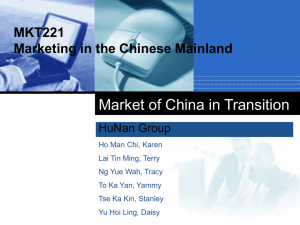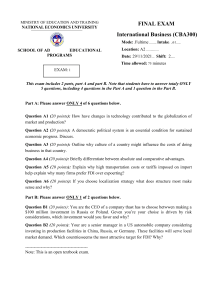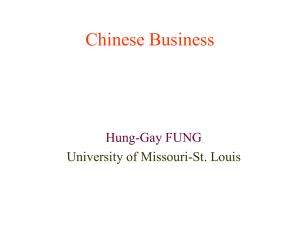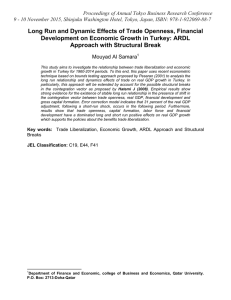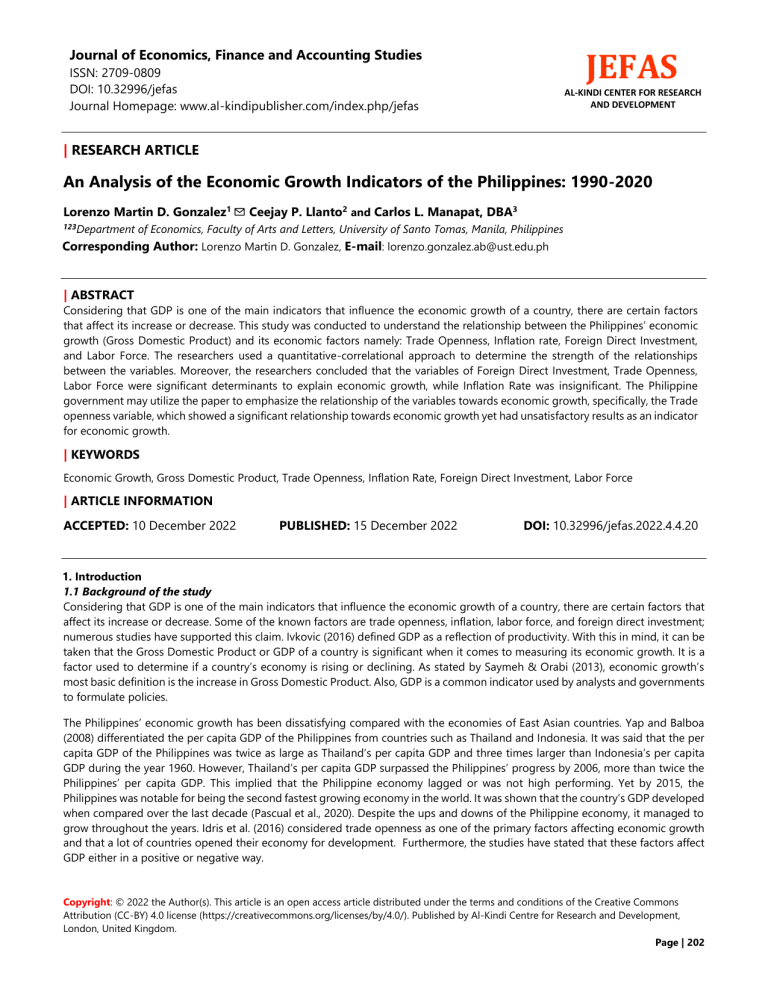
Journal of Economics, Finance and Accounting Studies JEFAS ISSN: 2709-0809 DOI: 10.32996/jefas Journal Homepage: www.al-kindipublisher.com/index.php/jefas AL-KINDI CENTER FOR RESEARCH AND DEVELOPMENT | RESEARCH ARTICLE An Analysis of the Economic Growth Indicators of the Philippines: 1990-2020 Lorenzo Martin D. Gonzalez1 ✉ Ceejay P. Llanto2 and Carlos L. Manapat, DBA3 123Department of Economics, Faculty of Arts and Letters, University of Santo Tomas, Manila, Philippines Corresponding Author: Lorenzo Martin D. Gonzalez, E-mail: lorenzo.gonzalez.ab@ust.edu.ph | ABSTRACT Considering that GDP is one of the main indicators that influence the economic growth of a country, there are certain factors that affect its increase or decrease. This study was conducted to understand the relationship between the Philippines’ economic growth (Gross Domestic Product) and its economic factors namely: Trade Openness, Inflation rate, Foreign Direct Investment, and Labor Force. The researchers used a quantitative-correlational approach to determine the strength of the relationships between the variables. Moreover, the researchers concluded that the variables of Foreign Direct Investment, Trade Openness, Labor Force were significant determinants to explain economic growth, while Inflation Rate was insignificant. The Philippine government may utilize the paper to emphasize the relationship of the variables towards economic growth, specifically, the Trade openness variable, which showed a significant relationship towards economic growth yet had unsatisfactory results as an indicator for economic growth. | KEYWORDS Economic Growth, Gross Domestic Product, Trade Openness, Inflation Rate, Foreign Direct Investment, Labor Force | ARTICLE INFORMATION ACCEPTED: 10 December 2022 PUBLISHED: 15 December 2022 DOI: 10.32996/jefas.2022.4.4.20 1. Introduction 1.1 Background of the study Considering that GDP is one of the main indicators that influence the economic growth of a country, there are certain factors that affect its increase or decrease. Some of the known factors are trade openness, inflation, labor force, and foreign direct investment; numerous studies have supported this claim. Ivkovic (2016) defined GDP as a reflection of productivity. With this in mind, it can be taken that the Gross Domestic Product or GDP of a country is significant when it comes to measuring its economic growth. It is a factor used to determine if a country’s economy is rising or declining. As stated by Saymeh & Orabi (2013), economic growth’s most basic definition is the increase in Gross Domestic Product. Also, GDP is a common indicator used by analysts and governments to formulate policies. The Philippines’ economic growth has been dissatisfying compared with the economies of East Asian countries. Yap and Balboa (2008) differentiated the per capita GDP of the Philippines from countries such as Thailand and Indonesia. It was said that the per capita GDP of the Philippines was twice as large as Thailand’s per capita GDP and three times larger than Indonesia’s per capita GDP during the year 1960. However, Thailand’s per capita GDP surpassed the Philippines’ progress by 2006, more than twice the Philippines’ per capita GDP. This implied that the Philippine economy lagged or was not high performing. Yet by 2015, the Philippines was notable for being the second fastest growing economy in the world. It was shown that the country’s GDP developed when compared over the last decade (Pascual et al., 2020). Despite the ups and downs of the Philippine economy, it managed to grow throughout the years. Idris et al. (2016) considered trade openness as one of the primary factors affecting economic growth and that a lot of countries opened their economy for development. Furthermore, the studies have stated that these factors affect GDP either in a positive or negative way. Copyright: © 2022 the Author(s). This article is an open access article distributed under the terms and conditions of the Creative Commons Attribution (CC-BY) 4.0 license (https://creativecommons.org/licenses/by/4.0/). Published by Al-Kindi Centre for Research and Development, London, United Kingdom. Page | 202 JEFAS 4(4): 202-210 Hence, the researchers aim to examine the relationship between the independent variables: Trade Openness (TO), Foreign Direct Investment (FDI), Labor Force (LF), and Inflation (INF) towards the dependent variable: Gross Domestic Product (GDP). 1.2 Statement of the Problem This paper aims to measure the relationship of the variables towards GDP and to provide data beneficial to the Philippine economy. Therefore, the researchers seek to answer the following question: 1. Is there a significant relationship between the GDP of the Philippines and the country’s Trade Openness, Foreign Direct Investment, Labor Force, and Inflation Rate? 1.3 Hypothesis The researchers attempted to accept or reject the following hypothesis: Hypothesis: H0: The Philippines’ GDP has no significant relationship with the country’s Trade Openness, Foreign Direct Investment, Labor Force, and Inflation Rate 1.4 Scope and Limitations of the Study This research was carried out to study the 30-year annual relationship between the Philippines’ Trade Openness (TO), Foreign Direct Investment (FDI), Labor Force (LF), and Inflation (INF) on Gross Domestic Product from 1990-2020 only. The data utilized in this study is limited based on what is available from the database of the World Bank. The data 1wwas tested using Gretl, a crossplatform software package for econometric analysis. The Gretl software was used as it is easily accessible and does not require a paid subscription to run statistical tests. 1.5 Significance of the Study This study is significant as it aims to understand the relationship between the Philippines’ economic growth and its economic factors from 1990-2020. Also, this study serves as a basis for the government and policymakers to implement better policies and conduct decisions to further develop the Philippine economy in the long run. Future researchers would also acquire ideas of how Trade Openness, Foreign Direct Investment, Labor Force, and Inflation Rate affect economic growth. Lastly, this study could serve as a reference for future studies. 1.6 Theoretical Framework Labor Force Foreign Direct Investment Trade Openness Gross Domestic Product Dependent Variable Inflation Independent Variables Figure 1. Theoretical Framework Page | 203 An Analysis of the Economic Growth Indicators of the Philippines: 1990-2020 1.6.1 Exogenous Theory This paper focused on two theories that are in line with the discussion of the variables and their relationships towards each other. Firstly, Odhiambo and Mahembe (2014) stated the Exogenous theory is focused on explaining the relationship between foreign direct investment as capital accumulation and trade openness as trade liberalization towards economic growth. The theory states that FDI boosts capital and advances technological innovation while increased trade liberalization positively affects economic growth in GDP. 1.6.2 Neo-Classical Growth Theory The second theory is the Neo-classical growth model, which is based on the exogenous theory focused on inflation and labor force in the model. It states that economic equilibrium is a result of varying amounts of labor and capital. Economists in neo-classical gave their own explanation for the relationship between inflation and economic growth. Inflation might permanently increase the output growth rate by stimulating capital accumulation due to households holding less in money balance and more in other assets (Mudell, 1963 & Tobin, 1965, as cited in Mamo 2012). In addition, Mamo (2012) also stated that the relationship between inflation and economic growth portrays mixed results in the neo-classical model. 1.7 Operational Framework PROCESS INPUT Dependent Variable • Gross Domestic Product Independent Variable • Labor Force • Foreign Direct Investment • Trade Openness • Inflation • • Multiple Regression Data Treatment OUTPUT • • Identifying significant variables and their relationships Suggestions for policymakers Figure 2. IPO Model The operation framework portrays the step-by-step method that the variables would go through. The input would include all the necessary variables of this study, the independent variables, together with the dependent variable. The process involves the statistical tests and treatment that the researchers would make use of. For the final step, the researchers must be able to interpret the results and fulfill the goals of the study. 1.8 Definition of Terms Gross Domestic Product – overall value of goods and services produced in a country annually. Trade Openness or Trade Liberalization – the idea of how free or how strict a country is when it comes to foreign trade/relations. Foreign Direct Investment – investment done by one country to another. Labor Force – the sum of employed and unemployed people Inflation – generally refers to the increase in prices over a period 2. Literature Review A. Economic Growth (GDP) and Trade Openness The study by Zarria (2021) examined the effect of FDI and Trade Openness on economic growth. FDI flows to Morocco are expected to contribute to economic growth, especially in the long term. The author found that FDI has a positive effect on Morocco’s economic growth with the help of trade liberalization. In the case of Vietnam, a study conducted by Su et al. (2019) investigated the significance of economic openness in the growth of Vietnam’s economy, wherein the main findings of the researchers concluded the positive impact on the economic growth of FDI and trade openness combined. In the research conducted by Nketiah et al. (2020), FDI was reported to have a negative impact, but trade openness affects economic growth positively. Additionally, Khamphengvong, Srithilat, & Enjun (2017) investigated the relationship between trade openness, FDI, and economic development Page | 204 JEFAS 4(4): 202-210 in Laos. The findings have mentioned that FDI and trade resulted in a positive sign for economic growth in the distant future and that trade liberalization promotes FDI in Lao PDR. A study by Ridzuan A. R. et al. (2018) conducted in Malaysia focused on the effects of FDI and trade openness. The research showed a positive correlation between FDI and trade openness on economic growth and wealth distribution. The study by Tahmad, A. M. I., & Adow, A. H. (2018) investigates long-run equilibrium relationships between trade openness and FDI in the Sudanese economy by sector within the 1990-2017 period. The results showed that FDI and trade openness have a positive relationship in determining economic growth. (Saleem, H., Shabbir, M. S., & Bilal khan, M., 2020) Found that FDI and trade openness are correlated in contributing to economic growth. Similarly, according to Kakar, Z. K., & Khilji, B. A. (2011), trade openness will continue to be viewed as a key determinant of economic growth in Malaysia. Amna Intisar R. et al. (2020) found that a positive relationship between trade openness and economic growth exists in Asian countries. Hye, Q. M. A. (2016) shows that new evidence in their study was discovered and shows a strong correlation between trade openness and human capital in enhancing economic growth. Nepal, R et al. (2021) has found that both FDI and Trade Openness influence economic growth in India B. GDP and Foreign Direct Investment Sengupta & Puri (2018) attempted to explore the causality between FDI and GDP by comparing India with its neighbor countries. The study concluded that FDI enhances economic growth, excluding Pakistan, proving also that correlation exists between FDI and GDP. The study by Susilo (2018) examined the impact of FDI on economic growth in the United States, concluding that growth in FDI explained the 90.4% real GDP growth. This shows that an increase in FDI, together with GDP, affects economic growth positively. Pegkas (2015) found that FDI has a positive and significant impact on economic growth, as economic theory predicts. A study by Sokang, K. (2018) investigated the impact of FDI on economic growth in Cambodia, with results showing that there is a positive relationship between economic growth (GDP) and FDI. The researcher noted that this could have been caused by Cambodia’s sufficient FDI fund investments, which caused the economy’s growth. According to Hansen and Rand (2006), FDI and Growth in Developing Countries state that FDI promotes economic growth. The research of Čičak & Sorić (2015) focuses on the correlation between the GDP growth rate in Croatia and FDI; the study later on, found that GDP growth is caused by FDI and provided evidence that FDI is caused by GDP. Abbas et al. (2011) discussed in their paper the impact of FDI on GDP Growth, resulting in a positive relationship between the two. According to Agrawal, P. (2020), higher GDP growth and additional credit availability are associated with increased foreign direct investment. – stated that the variables have a strongly positive effect on economic growth. An empirical analysis of Bangladesh done by Hussain and Haque (2016) showed a relationship between foreign direct investments, trade, and the growth rate of per capita GDP. The study showed that the variables had a significant impact on the country’s GDP per capita growth rate. Sajilan et al. (2019) investigated 42 OIC countries to study the link between FDI and its several determinants. The researchers found that FDI is a valuable source of foreign capital and guarantees long-term economic growth. A study by Suluk & Ozturk (2020) examined the relationship between FDI and economic growth in the U.S. the results of the study implied the importance of FDI and that it positively affects economic growth in the U.S. Coban & Yussif (2019) studied the relationships of FDI, economic growth, and inflation for the country of Ghana. The authors concluded that FDI inflows and the economic growth of Ghana are positively related. Furthermore, Hakizimana (2015) explored the correlation between GDP per capita and FDI in Rwanda; his findings showed a robust relation between GDP per capita and FDI that leads to positive economic growth. It is indicated in the concluding remarks of Türkcan et al. (2008) that their findings suggest a positive correlation between FDI and economic growth. Wherein FDI positively influences economic growth and vice versa. The empirical evidence of Alfaro et al. (2004) suggests the significant contribution of FDI to economic growth. The analysis of Mun et al. (2008) shows a positive relationship between economic growth and FDI. Trade openness boosts GDP growth once it reaches a minimum threshold (Ramzan et al., 2019). In the study of Keho (2017) and Malefane & Odhiambo (2018), trade openness was found to have a significant effect on economic growth. Increasing trade openness contributes to GDP per capita, also lagged openness and openness obtained from the past years affect economic growth positively (Ma et al., 2019) C. GDP and Inflation Rate Mamo (2012) stated that inflation had caused economic growth for all the countries tested. On the contrary, Akinsola & Odhiambo (2017) and Adaramola & Dada (2020) concluded that inflation negatively affects economic growth. Furthermore, the relationship between inflation and economic growth varies in each country (Tien, 2021). Also, Boujelbene & Kamel (2017) discovered in their study a significant negative relationship between economic growth and inflation. D. GDP and Labor Force The study conducted by Chidoko (2014) found a positive relationship between labor and economic growth. In addition, Sari & Saputra (2020) stated that investment and labor have a significant relationship with economic growth. The results of Keho (2017) supported a long-run relationship between economic growth, labor, trade openness, and capital stock. Moreover, a statistically significant relationship between GDPs per capita and human capital was found in the study of Pelinescu (2015). Sustained economic growth can be achieved through high labor productivity (Fedulova et al., 2019). Page | 205 An Analysis of the Economic Growth Indicators of the Philippines: 1990-2020 3. Methodology This chapter focuses on the methodology used for data and its presentation of the interpretation of the results. Furthermore, statistical tools were individually discussed for the reader to fully understand the method of data interpretation. 3.1 Research Design The study used a quantitative-correlational approach to determine the strength of the relationships between the variables. The dependent variable, GDP, was studied with the independent variables of TO, FDI, LF, INF in mind to detect any linear correlation. The Ordinary Least Squares model was used to determine the level of significance of each independent variable towards the dependent variable. The validity of OLS is determined by various robustness tests that satisfy the assumptions of the model. 3.2 Data Gathering Procedure The data was gathered from the World Bank’s Online Indicator Database, which provided data from 1990-2020 for the variables of the study. The time-series was done annually, and a total of 31 observations were available for each variable. 3.3 Descriptions of Variables Gross Domestic Product Trade Openness GDP TO GDP (Current US$) Trade (% of GDP) Foreign Direct Investment FDI Foreign Direct Investment, net inflows (BoP, Current US$) Labor Force LF Labor Force, total Inflation INF Inflation, Consumer Prices (Annual %) Table 1. Description of Variables The table above shows the descriptions of each variable taken from the World Bank Online Database. 3.4 Statistical Tool The data were tested using GretL, a cross-platform software package for econometric analysis. The GretL software was used as it is easily accessible and does not require a paid subscription to run statistical tests. 4. Results and Discussion The researchers used data from World Bank to acquire results for their study entitled “The Relationship of Foreign Direct Investment, Trade Openness, Labor Force, and Inflation on Economic Growth”, with Gross Domestic Product as the dependent variable while Foreign Direct Investment, Trade Openness, Total Labor Force, Inflation Rate as the independent variables. The econometric model is expressed below: 𝑮𝑫𝑷 = 𝜷𝟎 + 𝜷𝟏 𝑻𝑶 + 𝜷𝟐 𝑭𝑫𝑰 + 𝜷𝟑 𝑰𝑵𝑭 + 𝜷𝟒 𝑳𝑭 + 𝝁 4.1 OLS Model 1 Model 1: OLS, using observations 1990-2020 (T = 31) Variables Dependent variable: GDPcurrentUS Coefficient Standard Error T-Ratio P-Value Const −1.21894e+011 4.15214e+010 −2.936 0.0069 TO −1.65418e+09 2.71737e+08 −6.087 <0.0001 FDI 11.0050 1.80904 6.083 <0.0001 INF −6.47927e+08 1.38596e+09 −0.4675 0.6440 LF 11026.7 931.206 11.84 <0.0001 Page | 206 JEFAS 4(4): 202-210 Mean dependent var Sum squared resid R-squared F(4, 26) 1.69e+11 7.94e+21 0.977812 286.4509 S.D. dependent var S.E. of regression Adjusted R-squared P-value(F) 1.09e+11 1.75e+10 0.974398 4.33e-21 Table 2: Multiple Regression Results Table 2 presents the unadjusted multiple regression results between the dependent variable of GDP and the independent variables of Foreign Direct Investment, Trade Openness, Total Labor Force, and Inflation Rate. The model shows an R2 value of 0.97, which indicates that the data acquired fits the model 97.78% of the time. The independent variables explain 97% of the variation in the dependent variable. The p-values also show that there the researchers should reject the null hypothesis that no significant relationship is present between the variables of TO, FDI, LF and the dependent variable of GDP. However, the researchers accept the null hypothesis that there is no significant relationship between INF and GDP. 4.2 OLS Model 2 Table 3: Adjusted Multiple Regression Results Model 2: OLS, using observations 1990-2020 (T = 31) Dependent variable: l_GDPcurrentUS Variables Coefficient Std. Error t-ratio p-value Const −20.6538 2.69727 −7.657 <0.0001 l_LF 2.57823 0.176869 14.58 <0.0001 l_FDI 0.109337 0.0325731 3.357 0.0024 TO −0.00963692 0.00159397 −6.046 <0.0001 IF −0.00525635 0.00830422 −0.6330 0.5323 Mean dependent var Sum squared resid R-squared F(4, 26) 25.64409 0.282711 0.978339 293.5737 S.D. dependent var S.E. of regression Adjusted R-squared P-value(F) 0.659581 0.104276 0.975006 3.17e-21 Table 3: Adjusted Multiple Regression Results Table 3 presents the adjusted multiple regression results between the dependent variable of GDP and the independent variables of Foreign Direct Investment, Trade Openness, Total Labor Force, and Inflation Rate. The model shows an R2 value of 0.97, which indicates that the data acquired fits the model 97.83% of the time. The independent variables explain 97% of the variation in the dependent variable. The p-values also show that there the researchers should reject the null hypothesis that no significant relationship is present between the variables of TO, FDI, LF and the dependent variable of GDP. However, the researchers accept the null hypothesis that there is no significant relationship between INF and GDP. 4.3 Ending Discussion The researchers used an adjusted dataset OLS result as opposed to the study of Mortera, Ocampo, Suin (2022), which used unadjusted data for the OLS results. GDP, FDI, and LF were transformed into their logarithmic form. The adjusted dataset OLS results show that the independent variables, excluding the inflation rate, showed a significant relationship with the dependent variable of GDP. The assumption of the Exogenous theory has been met, seeing that the coefficient of FDI shows a positive relationship with GDP. On the other hand, TO show a negative coefficient which can explain that trade liberalization is not a good indicator for economic growth in the Philippines, similar to a study by Ozturk, O., & Radouai, N. (2020), stating that trade openness has both short and long-run implications towards economic growth and are statistically significant but the contributions of trade openness to economic growth, are above all else, negligible results. The assumptions of the Neo-classical growth model for LF have been met, seeing that the coefficient shows a positive relationship with GDP. However, the inflation rate has a p-value that accepts the null hypothesis that it is insignificant towards economic growth, which means that the inflation rate is not a good indicator of economic growth. The result for INF is also backed by the study of Karki, S., Banjara, S., and Dumre, A. (2020), which show that inflation harmfully affects economic growth. The findings do not match the findings of Mudell (1963) and Tobin (1965), which stated that inflation could permanently lead to economic growth. Page | 207 An Analysis of the Economic Growth Indicators of the Philippines: 1990-2020 5. Summary, Conclusions, Recommendations 5.1. Summary and Conclusions The researchers aimed to seek the answer for if there is a significant relationship between the variables Foreign Direct Invest, Labor Force, Inflation Rate, and trade openness towards the Philippine’s Economic Growth measured in Gross Domestic Product. The researchers found that there is a significant relationship between the variables Foreign Direct Investment, Trade Openness, Labor Force towards the dependent variable of Gross Domestic Product, while the results for Inflation Rate was insignificant to explain economic growth. The results showed that the variables were able to explain 97% of the model for economic growth. The cleansing of data to fit robustness checks was also done but gave the researchers an insufficient OLS result. Based on the study of Mortera, Ocampo, Suin (2022), which also focused on the study of economic growth in the Philippines during the year 1987-2018, had a similar problem in which the researchers foregone the process of cleansing data and used the unadjusted data for the OLS results. For this study, the researchers used an adjusted form of data by only transforming the variables of Gross Domestic Product, Foreign Direct Investment, and Labor Force to their logarithmic forms for discussion. The researchers concluded that the variables of FDI, TO, and LF were significant determinants to explain economic growth, while INF was insignificant. 5.2 Recommendations The researchers recommend using a different procedure in analyzing the data that can result in using transformed data for the final regression results. Future researchers can also find different variables that are determinants of economic growth along with a different set of economic theories. The researchers used the logarithmic form for Gross Domestic Product, Labor Force, and Foreign Direct Investment which was different from what previous studies had done. The researchers recommend using this procedure for future studies, but it is warned that mixed results may occur. Nevertheless, the researchers also recommend using the proper procedure for transforming variables and using the transformed data set for the final OLS interpretation. The Philippine government may also use the paper to emphasize the relationship of the variables towards economic growth, specifically, the Trade openness variable, which showed a significant relationship towards economic growth yet had unsatisfactory data for economic growth. The researchers suggest looking into the relationship between these two variables further. Funding: This research received no external funding. Conflicts of Interest: The authors declare no conflict of interest. Acknowledgement: The researchers would like to give their thanks to the following for their guidance and assistance: To our family for giving us the opportunity to study and conduct this research To our classmates who gave their time and support whenever we need To our thesis professor, Sir Andrew Gonzalez, for his reminders and guidance for our section To our thesis adviser, Professor Carlos L. Manapat, DBA., for his knowledge and professionalism that made our research possible To Lord God for His never-ending mercy and glory Publisher’s Note: All claims expressed in this article are solely those of the authors and do not necessarily represent those of their affiliated organizations, or those of the publisher, the editors and the reviewers. References [1] [2] [3] [4] [5] [6] Abbas, Q., Akbar, S., Nasir, A. S., Ullah, H. A., & Naseem, M. A. (2011). Impact of Foreign Direct Investment on Gross Domestic Product. Global Journal of Management and Business Research, 11(8). https://globaljournals.org/GJMBR_Volume11/5-Impact-of Foreign-DirectInvestment-onGross-Domestic-Product.pdf Agrawal, P. (2020). Economic impact of foreign direct investment in South Asia. India and the WTO, 117. https://openknowledge.worldbank.org/bitstream/handle/10986/15082/9780821354100.pdf?seque nce=4#page=129 Ahmed, A. E. M., & Suliman, S. Z. (2011). The long-run relationship between money supply, real GDP, and price level: Empirical evidence from Sudan. Journal of Business Studies Quarterly, 2(2), 68. https://www.researchgate.net/profile/SulimanAbdalla/publication/268410503_The_Long Run_Relationship_Between_Money_Supply_Real_GDP_and_Price_Level_Empirical_Evidence _From_Sudan/links/588d1343aca272fa50df5598/The-Long-Run-Relationship-Between-Money Supply-Real-GDP-and-Price-LevelEmpirical-Evidence-From-Sudan.pdf Akinsola, F. A., & Odhiambo, N. M. (2017). Inflation and economic growth: A review of the international literature. Comparative Economic Research. Central and Eastern Europe, 20(3), 41–56. https://doi.org/10.1515/cer-2017-0019 al_Evidence_from_South_Africa/links/5af9ce04aca272e730289829/Impact-of-Trade-Openness on-Economic-Growth-Empirical-Evidencefrom-South-Africa.pdf Alfaro, L., Chanda, A., Kalemli-Ozcan, S., & Sayek, S. (2004). FDI and economic growth: the role of local financial markets. Journal of international economics, 64(1), 89-112. https://d1wqtxts1xzle7.cloudfront.net/30206053/fdipaper25-with-coverpagev2.pdf?Expires=1653120246&Signature=OE3TNAcxAJB3qn3ASakr5BbVPd3cSsWQtI9jeFE9j 6yKKazhpanrHP51i6dUc3akoAIX5AxfKJjs8VwMBuKDWtEAgDd Page | 208 JEFAS 4(4): 202-210 [7] [8] [9] [10] [11] [12] [13] [14] [15] [16] [17] [18] [19] [20] [21] [22] [23] [24] [25] [26] [27] [28] [29] [30] [31] [32] [33] [34] [35] [36] Amna Intisar, R., Yaseen, M. R., Kousar, R., Usman, M., & Makhdum, M. S. A. (2020). Impact of trade openness and human capital on economic growth: a comparative investigation of Asian countries. Sustainability, 12(7), 2930. Aziz, R. N. A. R., & Azmi, A. (2017). Factors affecting gross domestic product (GDP) growth in Malaysia. International Journal of Real Estate Studies, 11(4), 61-67. https://www.utm.my/intrest/files/2017/09/07-FACTOR-AFFECTING-GROSS-DOMESTIC PRODUCT Chidoko, C. (2014). Labor and economic growth in Zimbabwe. The Economics and Finance Letters, 1(4), 24–29. https://doi.org/10.18488/journal.29/2014.1.4/29.4.24.29 Čičak, K., & Sorić, P. (2015). The interrelationship of FDI and GDP in European transition countries. The International Journal of Management Science and Business Administration, 1(4), 41–58. https://doi.org/10.18775/ijmsba.1849-5664-5419.2014.14.1003 Coban, O., & Yussif, A.-R. B. (2019). RELATIONSHIPS BETWEEN ECONOMIC GROWTH, FOREIGN DIRECT INVESTMENT AND INFLATION: ARDL MODELS APPROACH FOR THE CASE OF GHANA. Eurasian Research Journal, 1(2). https://dergipark.org.tr/tr/download/articlefile/785092 Dammak, T. B., & Helali, K. (2017). Threshold effects on the relationship between inflation rate and economic growth in Tunisia. International Economic Journal, 31(2), 310–325. https://doi.org/10.1080/10168737.2017.1289546 economic growth rate in Jordan. Asian Economic and Financial Review, 3(3), 341-354. https://archive.aessweb.com/index.php/5002/article/view/997/1480 Fedulova, I., Voronkova, O., Zhuravlev, P., Gerasimova, E., Glyzina, M., & Alekhina, N. (2019). Labor productivity and its role in the Sustainable Development of Economy: On the example of a region. Entrepreneurship and Sustainability Issues, 7(2), 1059–1073. https://doi.org/10.9770/jesi.2019.7.2(19) Hakizimana, J. (2015). The relationship between foreign direct investment (FDI) and GDP per capita in Rwanda. SSRN Electronic Journal. https://doi.org/10.2139/ssrn.2598413 Hansen, H., & Rand, J. (2006). On the causal links between FDI and growth in developing countries. The World Economy, 29(1), 21–41. https://doi.org/10.1111/j.1467-9701.2006.00756.x Har, W. M., Teo, K. L., & Yee, K. M. (2008). FDI and economic growth relationship: An empirical study on Malaysia. International Business Research, 1(2), 11-18. https://papers.ssrn.com/sol3/papers.cfm?abstract_id=1398282 https://doi.org/10.20961/bise.v4i1.21422 Hussain, M.E. and Haque, M. (2016). Foreign Direct Investment, Trade and Economic Growth: An Empirical Analysis of Bangladesh. Economies, 4, 1-14. https://www.mdpi.com/2227- 7099/4/2/7 Hye, Q. M. A. (2016). Long-term effect of trade openness on economic growth in the case of Pakistan. Quality & Quantity, 46(4), 11371149. Idris, J., Yusop, Z., & Habibullah, M. S. (2016). Trade openness and economic growth: A causality test in panel perspective. International Journal of Business and Society, 17(2). https://publisher.unimas.my/ojs/index.php/IJBS/article/view/525 Ivković, A. F. (2016). Limitations of the GDP as a measure of progress and well being. Ekonomskivjesnik/EconviewsReview of Contemporary Business, Entrepreneurship Economic Issues, 29(1), 257-272. https://hrcak.srce.hr/ojs/index.php/ekonomski-vjesnik/article/view/4217/2459 Kakar, Z. K., & Khilji, B. A. (2011). Impact of FDI and trade openness on economic growth: A comparative study of Pakistan and Malaysia. Theoretical and Applied Economics, 11(11), 53. Karki, S., Banjara, S., & Dumre, A. (2020). A review of the impact of inflation on economic growth in Nepal. Archives of Agriculture and Environmental Science, 5(4), 576-582. https://doi.org/10.26832/24566632.2020.0504022 Keho, Y. (2017). The impact of trade openness on economic growth: The case of Cote d’Ivoire. Cogent Economics & Finance, 5(1), 1332820. https://www.tandfonline.com/doi/full/10.1080/23322039.2017.1332820 Khamphengvong, V., Enjun, X., & Srithilat, K. (2017). The relationship among FDI, trade openness and economic growth: Empirical evidence from Lao PDR. 2017 4th International Conference on Industrial Economics System and Industrial Security Engineering (IEIS). https://doi.org/10.1109/ieis.2017.8078623 Ma, J., Shi, J., Luo, D., & Che, Y. (2019). Effect of trade openness on regional economic growth in China: revisiting the discussion. Applied Economics Letters, 26(16), 1313-1316. https://www.tandfonline.com/doi/abs/10.1080/13504851.2018.1558331 Macovei, A. G. (2020). Impact of the consumer price index on Gross Domestic Product in Romania. Ecoforum Journal, 9(2). Mahembe, E., & Odhiambo, N. M. (2014). Foreign Direct Investment and economic growth: A theoretical framework. Journal of Governance and Regulation, 3(2), 63–70. https://doi.org/10.22495/jgr_v3_i2_p6 Malefane, M. R. (2018). Impact of trade openness on economic growth: Empirical evidence from South Africa. https://www.researchgate.net/profile/Nicholas Odhiambo/publication/325130173_Impact_of_Trade_Openness_on_Economic_Growth_Empiric Mamo, T. (2012). Economic Growth and Inflation A panel data analysis. Södertörns University | Department of Social Sciences| Economics Master Programme, Thesis. Mortera, S. G., Ocampo, J. V., & Suin, K. A. (2022). An empirical analysis on the determinants of the Philippine Economic Growth: 1987-2018. Journal of Economics, Finance and Accounting Studies, 4(2), 65–77. https://doi.org/10.32996/jefas.2022.4.2.6 Nepal, R., Paija, N., Tyagi, B., & Harvie, C. (2021). Energy security, economic growth and environmental sustainability in India: Does FDI and trade openness play a role? Journal of Environmental Management, 281, 111886. Ngangue, N., Amba, M. C., & Mbratana, T. (2017). Government expense, Consumer Price Index and Economic Growth in Cameroon. Nketiah, E., Cai, X., Adjei, M., & Boamah, B. B. (2020). Foreign direct investment, trade openness and economic growth: Evidence from Ghana. Open Journal of Business and Management, 08(01), 39–55. https://doi.org/10.4236/ojbm.2020.81003 Olugbenga Adaramola, A., & Dada, O. (2020). Impact of inflation on economic growth: Evidence from Nigeria. Investment Management and Financial Innovations, 17(2), 1–13. https://doi.org/10.21511/imfi.17(2).2020.01 Olugbenga Adaramola, A., & Dada, O. (2020). Impact of inflation on economic growth: Evidence from Nigeria. Investment Management and Financial Innovations, 17(2), 1–13. https://doi.org/10.21511/imfi.17(2).2020.01 Page | 209 An Analysis of the Economic Growth Indicators of the Philippines: 1990-2020 [37] Omugk2c5CNVmBMsQREFb93PSdLLreUUh6Fo0qByqliA68vNKnrhUmm3qwGDhuJlCu10t mnoQU1CoIJm1BhLbkpeu9frAMxl6kFsGc4m~Dd2bR3-M7kTU1XY5aY-JEDtshZ3tdcyKb5PaULNfv2TfdXj8PsHpvfVlF0Zs7syc07mFZqQPmeMco40oj5YgHWjtCju jAsSFADUMbv5mo4xcBA7eCz99pHFby7o4kW0XMlqH8MXr7uLo6qgxv0VqO7hIg__&Key Pair-Id=APKAJLOHF5GGSLRBV4ZA [38] Ozturk, O., & Radouai, N. (2020). DOES TRADE OPENNESS CONTRIBUTE TO ECONOMIC GROWTH AND DEVELOPMENT OF MOROCCO? JOURNAL OF ECONOMICS, BUSINESS, & ORGANIZATION RESEARCH, 443–453. [39] ÖZTÜRK, S., & SULUK, S. (2020). Economic growth and foreign direct investment in the United States: A Granger causality analysis. Yönetim Ve Ekonomi: Celal Bayar Üniversitesi İktisadi Ve İdari Bilimler Fakültesi Dergisi. https://doi.org/10.18657/yonveek.640568 [40] Pascual, K. C. A., Dionisio, C. P., & Capulla, R. (2020). The relationship of real Gross Domestic Product (GDP), inflation, and unemployment in the Philippines (1970–2011). International Journal of Research Studies in Education, 9(2). https://doi.org/10.5861/ijrse.2020.5804 [41] Pegkas, P. (2015). The impact of FDI on economic growth in Eurozone countries. The Journal of Economic Asymmetries, 12(2), 124–132. https://doi.org/10.1016/j.jeca.2015.05.001 [42] Pelinescu, E. (2015). The impact of human capital on economic growth. Procedia Economics and Finance, 22, 184–190. https://doi.org/10.1016/s2212-5671(15)00258-0 [43] PyApUgIJvkEozxK3J1knMm3mMi89wGHx2OJGmB3EeePqGButXZ7c4YT0- w08hKxCyqzLeWD0-BOa4kcBmB [44] RA~aX9DuMj1xBc~eP5DkRraf73SY3J5EqCRaZnl1QHhmfLwHneuAfG3tQyZLe0tFxuchxWT ~JlrbLIokRRnBxl~5lRbfMfMPAFB857LvSrb4PG1GaFa7RQifuwGxDBWfZX5q4btY7wTqRVXr38CxAjq1Zjnk2C2Er3Q__&Ke y-PairId=APKAJLOHF5GGSLRBV4ZA [45] Ramzan, M., Sheng, B., Shahbaz, M., Song, J., & Jiao, Z. (2019). Impact of trade openness on GDP growth: Does TFP matter? The Journal of International Trade & Economic Development, 28(8), 960-995. https://www.tandfonline.com/doi/abs/10.1080/09638199.2019.1616805 [46] Ridzuan, A. R., Ismail, N. A., & Hamat, A. F. C. (2018). Foreign direct investment and trade openness: do they lead to sustainable development in Malaysia? EDITORIAL BOARD, 81. https://jssm.umt.edu.my/wp-content/uploads/sites/51/2018/04/Journal_1.01.pdf#page=91 [47] Sajilan, S., Islam, M. U., Ali, M., & Anwar, U. (2019). The determinants of FDI in OIC countries. International Journal of Financial Research, 10(5), 466. https://doi.org/10.5430/ijfr.v10n5p466 [48] Saleem, H., Shabbir, M. S., & Bilal khan, M. (2020). The short-run and long-run dynamics among FDI, trade openness and economic growth: Using a bootstrap ARDL test for co integration in selected South Asian countries. South Asian Journal of Business Studies, 9(2), 279–295. https://doi.org/10.1108/sajbs-07-2019-0124 [49] Sari, I. U., & Saputra, A. (2020). The influence of small and medium enterprise growth, investment, and Labor on economic growth in Batam City. JIM UPB (Jurnal Ilmiah Manajemen Universitas Putera Batam), 9(1), 31–36. https://doi.org/10.33884/jimupb.v9i1.2686 [50] Saymeh, A. A. F., & Orabi, M. M. A. (2013). The effect of interest rate, inflation rate, GDP on real [51] Sengupta, P., & Puri, R. (2018). Exploration of the relationship between FDI and GDP: A comparison between India and its neighbouring countries. Global Business Review, 21(2), 473– 489. https://doi.org/10.1177/0972150918760026 [52] Shinkarenko, V., Hostryk, A., Shynkarenko, L., & Dolinskyi, L. (2021). A forecasting of the consumer price index using time series model. In SHS Web of Conferences (Vol. 107, p. 10002). EDP Sciences [53] Sokang, K. (2018). The impact of foreign direct investment on the economic growth in Cambodia: Empirical evidence. International Journal of Innovation and Economic Development, 4(5), 31-38.https://www.researchgate.net/profile/SokangKhun 2/publication/330506086_The_Impact_of_Foreign_Direct_Investment_onthe_Economic_Growth_in_Cambodia_Empirical_Evidence/links/ 5c4ede9392851c22a39628ea/The Impact-of-Foreign-Direct-Investment-on-the-Economic-Growth-in-Cambodia-Empirical Evidence.pdf [54] Su, D. T., Nguyen, P. C., & Schinckus, C. (2019). Impact of foreign direct investment, trade openness and economic institutions on growth in emerging countries: The case of Vietnam. Journal of International Studies, 12(3), 243–264. https://doi.org/10.14254/20718330.2019/12- 3/20 [55] Susilo, D. (2018). The impact of foreign direct investment on economic growth (a causal study in the United States). BISE: Jurnal Pendidikan Bisnis Dan Ekonomi, 4(1). [56] Tahmad, A. M. I., & Adow, A. H. (2018). The impact of trade openness on foreign direct investment in Sudan by sector in the 19902017 period: an empirical analysis. Economic annals XXI, (172), 14-22. https://www.ceeol.com/search/article-detail?id=731883 [57] Tien, N. (2021). Relationship between inflation and economic growth in Vietnam. Turkish Journal of Computer and Mathematics Education, 12(14), 5134–5139. [58] Türkcan, B., Duman, A., & Yetkiner, I. H. (2008, May). How does FDI and economic growth affect each other? the OECD case. In International conference on emerging economic issues in a globalizing world (pp. 21-40). Izmir: Izmir University of Economics and Suny Cortland. https://d1wqtxts1xzle7.cloudfront.net/51099387/How_Does_FDI_and_Economic_Growth_Affec t_20161228-24492-19713x-withcover-page [59] v2.pdf?Expires=1653120287&Signature=b84jBNHoG6aoXTUmc9IJzgpdQ7beOeQSYgqtNZ3W5Q7sb4vhAEIFefz95GdKELGyDYr5l69ffJ7w~XrJz [60] Yap, J., & Balboa, J. (2008). Why has the Philippines lagged? The East Asian Bureau Econ. Res.(EABER) Newsletter. https://eaber.org/wpcontent/uploads/2011/05/EABER_Newsletter_October2008.pdf [61] Zarria, F. (2021). Effects of FDI and Trade Openness on Economic Growth in Morocco. International Journal of Scientific Engineering and Science, 5(3). http://ijses.com/wpcontent/uploads/2021/04/61-IJSES-V5N3.pdf Page | 210
